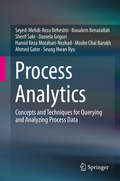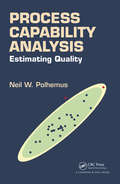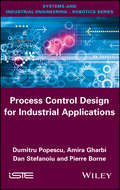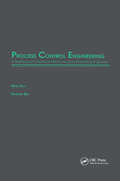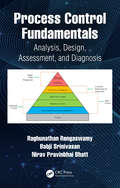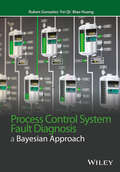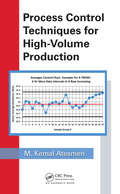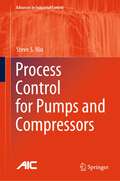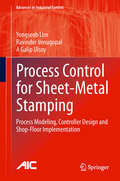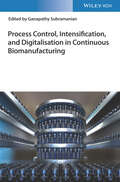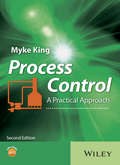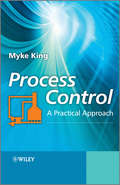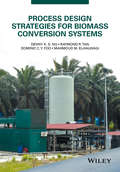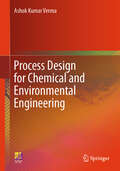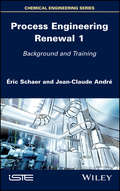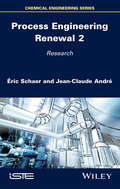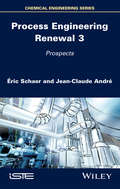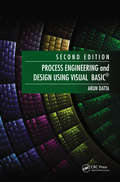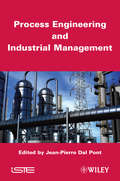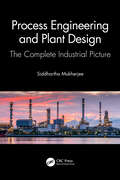- Table View
- List View
Process Analytics
by Seyed-Mehdi-Reza Beheshti Boualem Benatallah Sherif Sakr Daniela Grigori Hamid Reza Motahari-Nezhad Moshe Chai Barukh Ahmed Gater Seung Hwan RyuThis book starts with an introduction to process modeling and process paradigms, then explains how to query and analyze process models, and how to analyze the process execution data. In this way, readers receive a comprehensive overview of what is needed to identify, understand and improve business processes. The book chiefly focuses on concepts, techniques and methods. It covers a large body of knowledge on process analytics - including process data querying, analysis, matching and correlating process data and models - to help practitioners and researchers understand the underlying concepts, problems, methods, tools and techniques involved in modern process analytics. Following an introduction to basic business process and process analytics concepts, it describes the state of the art in this area before examining different analytics techniques in detail. In this regard, the book covers analytics over different levels of process abstractions, from process execution data and methods for linking and correlating process execution data, to inferring process models, querying process execution data and process models, and scalable process data analytics methods. In addition, it provides a review of commercial process analytics tools and their practical applications. The book is intended for a broad readership interested in business process management and process analytics. It provides researchers with an introduction to these fields by comprehensively classifying the current state of research, by describing in-depth techniques and methods, and by highlighting future research directions. Lecturers will find a wealth of material to choose from for a variety of courses, ranging from undergraduate courses in business process management to graduate courses in business process analytics. Lastly, it offers professionals a reference guide to the state of the art in commercial tools and techniques, complemented by many real-world use case scenarios.
Process Capability Analysis: Estimating Quality
by Neil W. PolhemusProcess Capability Analysis: Estimating Quality presents a systematic exploration of process capability analysis and how it may be used to estimate quality. The book is designed for practitioners who are tasked with insuring a high level of quality for the products and services offered by their organizations. Along with describing the necessary statistical theory, the book illustrates the practical application of the techniques to data that do not always satisfy the standard assumptions. <P><P> The first two chapters deal with attribute data, where the estimation of quality is restricted to counts of nonconformities. Both classical and Bayesian methods are discussed. The rest of the book deals with variable data, including extensive discussions of both capability indices and statistical tolerance limits. Considerable emphasis is placed on methods for handling non-normal data. Also included are discussions of topics often omitted in discussions of process capability, including multivariate capability indices, multivariate tolerance limits, and capability control charts. A separate chapter deals with the problem of determining adequate sample sizes for estimating process capability. <P><P> Features: <li> Comprehensive treatment of the subject with consistent theme of estimating percent of nonconforming product or service. <li> Includes Bayesian methods. <li> Extension of univariate techniques to multivariate data. <li> Demonstration of all techniques using Statgraphics data analysis software. <P><P> Neil Polhemus is Chief Technology Officer at Statgraphics Technology and the original developer of the Statgraphics program for statistical analysis and data visualization. Dr. Polhemus spent 6 years on the faculty of the School of Engineering and Applied Science at Princeton University before moving full-time to software development and consulting. He has taught courses dealing with statistical process control, design of experiments and data analysis for more than 100 companies and government agencies.
Process Control Design for Industrial Applications
by Pierre Borne Dumitru Popescu Dan Stefanoiu Amira GharbiThis book presents the most important methods used for the design of digital controls implemented in industrial applications. The best modelling and identification techniques for dynamical systems are presented as well as the algorithms for the implementation of the modern solutions of process control. The proposed described methods are illustrated by various case studies for the main industrial sectors There exist a number of books related each one to a single type of control, yet usually without comparisons for various industrial sectors. Some other books present modelling and identification methods or signal processing. This book presents the methods to solve all the problems linked to the design of a process control without the need to find additional information.
Process Control Engineering
by A.Ramachandro. RaoProcess Control Engineering is a textbook for chemical, mechanical and electrical engineering students, providing the theoretic fundamentals of control systems, and highlighting modern control theory and practical aspects of industrial processes. The introductory nature of the text should appeal to undergraduate students, while later chapters on linear systems, optimal control, adaptive control and intelligent control are directed toward advanced students and practising engineers. The textbook has been extensively tested in both undergraduate and graduate courses at the University of Alberta.
Process Control Fundamentals: Analysis, Design, Assessment, and Diagnosis
by Raghunathan Rengaswamy Babji Srinivasan Nirav Pravinbhai BhattThe field of process control has evolved gradually over the years, with emphasis on key aspects including designing and tuning of controllers. This textbook covers fundamental concepts of basic and multivariable process control, and important monitoring and diagnosis techniques. It discusses topics including state-space models, Laplace transform to convert state-space models to transfer function models, linearity and linearization, inversion formulae, conversion of output to time domain, stability analysis through partial fraction expansion, and stability analysis using Routh table and Nyquits plots. The text also covers basics of relative gain array, multivariable controller design and model predictive control. The text comprehensively covers minimum variable controller (MVC) and minimum variance benchmark with the help of solved examples for better understanding. Fundamentals of diagnosis of control loop problems are also explained and explanations are bolstered through solved examples. Pedagogical features including solved problems and unsolved exercises are interspersed throughout the text for better understanding. The textbook is primarily written for senior undergraduate and graduate students in the field of chemical engineering and biochemical engineering for a course on process control. The textbook will be accompanied by teaching resource such a collection of slides for the course material and a includsolution manual for the instructors.
Process Control System Fault Diagnosis: A Bayesian Approach
by Biao Huang Ruben Gonzalez Fei QiProcess Control System Fault Diagnosis: A Bayesian Approach Ruben T. Gonzalez, University of Alberta, Canada Fei Qi, Suncor Energy Inc., Canada Biao Huang, University of Alberta, Canada Data-driven Inferential Solutions for Control System Fault Diagnosis A typical modern process system consists of hundreds or even thousands of control loops, which are overwhelming for plant personnel to monitor. The main objectives of this book are to establish a new framework for control system fault diagnosis, to synthesize observations of different monitors with a prior knowledge, and to pinpoint possible abnormal sources on the basis of Bayesian theory. Process Control System Fault Diagnosis: A Bayesian Approach consolidates results developed by the authors, along with the fundamentals, and presents them in a systematic way. The book provides a comprehensive coverage of various Bayesian methods for control system fault diagnosis, along with a detailed tutorial. The book is useful for graduate students and researchers as a monograph and as a reference for state-of-the-art techniques in control system performance monitoring and fault diagnosis. Since several self-contained practical examples are included in the book, it also provides a place for practicing engineers to look for solutions to their daily monitoring and diagnosis problems. Key features: * A comprehensive coverage of Bayesian Inference for control system fault diagnosis. * Theory and applications are self-contained. * Provides detailed algorithms and sample Matlab codes. * Theory is illustrated through benchmark simulation examples, pilot-scale experiments and industrial application. Process Control System Fault Diagnosis: A Bayesian Approach is a comprehensive guide for graduate students, practicing engineers, and researchers who are interests in applying theory to practice.
Process Control Techniques for High-Volume Production
by M. Kemal AtesmenThis book details most common statistical process control tools with many examples for high-volume production. It aims to make elements of high-volume production process control simple and easy to understand. It lets you thoroughly understand process controls instead of blindly trusting software tools that operate as black boxes. If you are dealing with high-volume production as an operator, line supervisor, inspector, process engineer, quality engineer, manufacturing manager, plant manager, or president of the company, you have to understand the statistical process control basics explained in this book in order to be successful.
Process Control for Pumps and Compressors (Advances in Industrial Control)
by Steve S. NiuThis book provides a summary of the essential knowledge and working processes involved with control of rotating equipment including:machine characteristics;overall control strategies;detailed design; andbest practices.Emphasis is placed on the role of pumps and compressors as part of the overall process flow rather than treating them in isolation as this tends to optimize energy efficiency.Readers are made aware of the critical roles of rotating equipment and are given a good understanding of their dynamic behaviors, including surge/choke. The author imparts the practical know-how and skills involved in the design and implementation of capacity and anti-surge control and safe-guarding logic. Furthermore, the book discusses real-time monitoring of solutions based on operational requirements, dynamic models for control of supply and demand, cause-and-effect relationships, the use of online and offline data, and collaboration with other engineering disciplines. The text facilitates support for the day-to-day operation of in-house open-platform compressor control applications, encouraging the growth of analytic skills in troubleshooting and fixing common problems; it also inculcates a basic understanding of the principles of third-party proprietary technologies and supports decision-making between in-house and third-party solutions.Process engineers working in the oil-and-gas, refining, petrochemical, and chemical industries who bear responsibility for designing control solutions involving pumps and compressors will find this book an invaluable source of practical advice. This book also helps engineers working on design and maintenance of rotating equipment to understand the perspectives and requirements of process control.
Process Control for Sheet-Metal Stamping
by Yongseob Lim Ravinder Venugopal A Galip UlsoyProcess Control for Sheet-Metal Stamping presents a comprehensive and structured approach to the design and implementation of controllers for the sheet metal stamping process. The use of process control for sheet-metal stamping greatly reduces defects in deep-drawn parts and can also yield large material savings from reduced scrap. Sheet-metal forming is a complex process and most often characterized by partial differential equations that are numerically solved using finite-element techniques. In this book, twenty years of academic research are reviewed and the resulting technology transitioned to the industrial environment. The sheet-metal stamping process is modeled in a manner suitable for multiple-input multiple-output control system design, with commercially available sensors and actuators. These models are then used to design adaptive controllers and real-time controller implementation is discussed. Finally, experimental results from actual shop floor deployment are presented along with ideas for further improvement of the technology. Process Control for Sheet-Metal Stamping allows the reader to design and implement process controllers in a typical manufacturing environment by retrofitting standard hydraulic or mechanical stamping presses and as such will be of interest to practising engineers working in metal-working, automotive and aeronautical industries. Academic researchers studying improvements in process control and how these affect the industries in which they are applied will also find the text of value.
Process Control, Intensification, and Digitalisation in Continuous Biomanufacturing
by Ganapathy SubramanianProcess Control, Intensification, and Digitalisation in Continuous Biomanufacturing Explore new trends in continuous biomanufacturing with contributions from leading practitioners in the field With the increasingly widespread acceptance and investment in the ??technology, the last decade has demonstrated the utility of continuous ??processing in the pharmaceutical industry. In Process Control, Intensification, and Digitalisation in Continuous Biomanufacturing, distinguished biotechnologist Dr. Ganapathy Subramanian delivers a comprehensive exploration of the potential of the continuous processing of biological products and discussions of future directions in advancing continuous processing to meet new challenges and demands in the manufacture of therapeutic products. A stand-alone follow-up to the editor’s Continuous Biomanufacturing: Innovative Technologies and Methods published in 2017, this new edited volume focuses on critical aspects of process intensification, process control, and the digital transformation of biopharmaceutical processes. In addition to topics like the use of multivariant data analysis, regulatory concerns, and automation processes, the book also includes: Thorough introductions to capacitance sensors to control feeding strategies and the continuous production of viral vaccines Comprehensive explorations of strategies for the continuous upstream processing of induced microbial systems Practical discussions of preparative hydrophobic interaction chromatography and the design of modern protein-A-resins for continuous biomanufacturing In-depth examinations of bioprocess intensification approaches and the benefits of single use for process intensification Perfect for biotechnologists, bioengineers, pharmaceutical engineers, and process engineers, Process Control, Intensification, and Digitalisation in Continuous Biomanufacturing is also an indispensable resource for chemical engineers seeking a one-stop reference on continuous biomanufacturing.
Process Control: A Practical Approach
by Myke KingSo why another book on process control? Process Control: A Practical Approach is a ground-breaking guide that provides everything needed to design and maintain process control applications. <P><P>The book follows the hierarchy from basic control, through advanced regulatory control, up to and including multivariable control. It addresses many process-specific applications including those on fired heaters, compressors and distillation columns. <P><P>Written with the practicing control engineer in mind, the book: Brings together proven design methods, many of which have never been published before Focuses on techniques that have an immediate practical application Minimizes the use of daunting mathematics - but for the more demanding reader, complex mathematical derivations are included at the end of each chapter Covers the use of all the algorithms, common to most distributed control systems This book raises the standard of what might be expected of even basic controls. In addition to the design methods it describes any shortcuts that can be taken and how to avoid common pitfalls. Proper application will result in significant improvements to process performance. Myke King's practical approach addresses the needs of the process industry, and will improve the working practices of many control engineers. "This book would be of value to process control engineers in any country." - Mr Andrew Ogden-Swift, Chairmain, Process Management and Control Subject Group, Institution of Chemical Engineers, UK "This book should take the process-control world by storm." - Edward Dilley, Lecturer in Process Control, ESD Simulation Training
Process Control: A Practical Approach
by Myke KingThis expanded new edition is specifically designed to meet the needs of the process industry, and closes the gap between theory and practice. Back-to-basics approach, with a focus on techniques that have an immediate practical application, and heavy maths relegated to the end of the book Written by an experienced practitioner, highly regarded by major corporations, with 25 years of teaching industry courses Supports the increasing expectations for Universities to teach more practical process control (supported by IChemE)
Process Control: A Practical Approach
by Myke KingSo why another book on process control? Process Control: A Practical Approach is a ground-breaking guide that provides everything needed to design and maintain process control applications. The book follows the hierarchy from basic control, through advanced regulatory control, up to and including multivariable control. It addresses many process-specific applications including those on fired heaters, compressors and distillation columns. Written with the practicing control engineer in mind, the book: Brings together proven design methods, many of which have never been published before Focuses on techniques that have an immediate practical application Minimizes the use of daunting mathematics – but for the more demanding reader, complex mathematical derivations are included at the end of each chapter Covers the use of all the algorithms, common to most distributed control systems This book raises the standard of what might be expected of even basic controls. In addition to the design methods it describes any shortcuts that can be taken and how to avoid common pitfalls. Proper application will result in significant improvements to process performance. Myke King’s practical approach addresses the needs of the process industry, and will improve the working practices of many control engineers. “This book would be of value to process control engineers in any country.” – Mr Andrew Ogden-Swift, Chairmain, Process Management and Control Subject Group, Institution of Chemical Engineers, UK “This book should take the process-control world by storm.” – Edward Dilley, Lecturer in Process Control, ESD Simulation Training
Process Control: Engineering Analyses and Best Practices (Advances in Industrial Control)
by Steve S. Niu Deyun XiaoProcess Control details the core knowledge and practical skills that a successful process control practitioner needs. It explains the essential technologies that are in use in current industrial practice or which may be wanting for the future. The book focuses on practical considerations, not only on those that make a control solution work, but also on those that prevent it from failing, especially for complex control loops and plant-wide control solutions.After discussing the indispensable role of control in modern process industries, the authors concentrate on the skills required for process analysis, control design, and troubleshooting. One of the first books to provide a systematic approach and structured methodology for process analysis and control design, Process Control illustrates that methodology with many practical examples that cover process control, equipment control, and control calculations derived from real projects and applications. The book uses 229 drawings and 83 tables to make the concepts it presents more intuitive and its methodology easy to follow.Process Control will help the practising control engineer to benefit from a wealth of practical experience and good ideas on how to make control work in the real world and students training to take up roles in process control are shown the applied relevance of control theory in the efficient functioning of industrial plant and the considerations needed to make it work.Advances in Industrial Control reports and encourages the transfer of technology in control engineering. The rapid development of control technology has an impact on all areas of the control discipline. The series offers an opportunity for researchers to present an extended exposition of new work in all aspects of industrial control.
Process Design Strategies for Biomass Conversion Systems
by Dominic C. Foo Denny K. Ng Mahmoud M. El-Halwagi Raymond R. TanThis book covers recent developments in process systems engineering (PSE) for efficient resource use in biomass conversion systems. It provides an overview of process development in biomass conversion systems with focus on biorefineries involving the production and coproduction of fuels, heating, cooling, and chemicals. The scope includes grassroots and retrofitting applications. In order to reach high levels of processing efficiency, it also covers techniques and applications of natural-resource (mass and energy) conservation. Technical, economic, environmental, and social aspects of biorefineries are discussed and reconciled. The assessment scales vary from unit- to process- and life-cycle or supply chain levels. The chapters are written by leading experts from around the world, and present an integrated set of contributions. Providing a comprehensive, multi-dimensional analysis of various aspects of bioenergy systems, the book is suitable for both academic researchers and energy professionals in industry.
Process Design for Chemical and Environmental Engineering
by Ashok Kumar VermaThis book discusses the design methodology for chemical process equipment carrying out heat and mass transfer operations and various types of reactors. Process design is an important step before achieving a mechanical design of chemical process equipment. It requires comprehensive knowledge of thermodynamics, fluid flow, heat, and mass transfer operations, and chemical reaction engineering, which is covered by the various chapters in this book. It covers process design of (1) heat exchangers, condensers, and reboilers; (2) packed and stage columns for distillation and gas absorption in chapter; (3) liquid–liquid extractor and solid–liquid leaching systems; (4) cooling towers; and (5) four different types of catalytic reactors, packed bed, fluidized bed, slurry bubble column, and mechanically agitated slurry reactor. The book emphasizes using correlations and equations in place of design data available in graphical or tabular forms to make it suitable for solving problems using spreadsheets and other software. It includes new correlations if not available in the literature and references to data available on web resources. The book covers all major topics for the course Chemical Process Engineering for undergraduate students and is also helpful in carrying out process design calculations for undergraduate design projects.
Process Design for Cryogenics
by Alexander AlekseevUp-to-date overview of the method for producing the main industrial gases This book covers process design for cryogenic processes like air separation, natural gas liquefaction, and hydrogen and helium liquefaction. It offers an overview of the basics of cryogenics and information on process design for modern industrial plants. Throughout, the book helps readers visualize the theories of thermodynamics related to cryogenics in practice. A central concept in the book is the connection between the theoretical world of process design and the real limitations given by available hardware components and systems. Sample topics covered in Process Design for Cryogenics include: Cryogenic gases like nitrogen, oxygen, argon, neon, hydrogen, helium, and methaneThermodynamicsTypical cryogenic refrigeration processes, including the classic Joule Thomson process, the contemporary mixed-gas Joule Thomson process, and expander-based processes like Brayton and Claude cyclesHelium and hydrogen liquefaction and air separation Process Design for Cryogenics is a comprehensive must-have resource for engineers and scientists working in academia and industry on cryogenic processes.
Process Engineering Renewal 1: Background and Training
by Jean-Claude André Éric SchaerProcess engineering emerged at the beginning of the 20th Century and has become an essential scientific discipline for the matter and energy processing industries. Its success is incontrovertible, with the exponential increase in techniques and innovations. Rapid advances in new technologies such as artificial intelligence, as well as current societal needs – sustainable development, climate change, renewable energy, the environment – are developments that must be taken into account in industrial renewal. Process Engineering Renewal 1 – the first volume of three – focuses on training, demonstrating the need for innovation in order for the field to have a framework that is sustainable, in a highly changeable world.
Process Engineering Renewal 2: Research
by Eric Schaer Jean-Claude AndreThe chemical processes initially consisted of non-scientific extrapolation methods from the "laboratory". Coming from the oil industry, chemical engineering, now process engineering (material and energy transformation) has introduced scientific rationality in the development of more optimal processes both in financial terms and saving material and energy. At the end of the twentieth century, heavy trends force us to modify our ways of doing matter and/or energies: depletion of reserves, pollution, globalization, artificial intelligence, public perception of risks, etc. Commodities continue to be produced locally while higher value-added products can come from many countries around the world. These external pressures on training and research in the field require major breaks that are the subject of the book.
Process Engineering Renewal 3: Prospects
by Eric Schaer Jean-Claude AndreThe chemical processes initially consisted of non-scientific extrapolation methods from the "laboratory". Coming from the oil industry, chemical engineering, now process engineering (material and energy transformation) has introduced scientific rationality in the development of more optimal processes both in financial terms and saving material and energy. At the end of the twentieth century, heavy trends force us to modify our ways of doing matter and/or energies: depletion of reserves, pollution, globalization, artificial intelligence, public perception of risks, etc. Commodities continue to be produced locally while higher value-added products can come from many countries around the world. These external pressures on training and research in the field require major breaks that are the subject of the book.
Process Engineering and Design Using Visual Basic
by Arun DattaSoftware tools are a great aid to process engineers, but too much dependence on such tools can often lead to inappropriate and suboptimal designs. Reliance on software is also a hindrance without a firm understanding of the principles underlying its operation, since users are still responsible for devising the design.In Process Engineering and Desi
Process Engineering and Industrial Management
by Jean-Pierre Dal PontProcess Engineering, the science and art of transforming raw materials and energy into a vast array of commercial materials, was conceived at the end of the 19th Century. Its history in the role of the Process Industries has been quite honorable, and techniques and products have contributed to improve health, welfare and quality of life. Today, industrial enterprises, which are still a major source of wealth, have to deal with new challenges in a global world. They need to reconsider their strategy taking into account environmental constraints, social requirements, profit, competition, and resource depletion."Systems thinking" is a prerequisite from process development at the lab level to good project management. New manufacturing concepts have to be considered, taking into account LCA, supply chain management, recycling, plant flexibility, continuous development, process intensification and innovation.This book combines experience from academia and industry in the field of industrialization, i.e. in all processes involved in the conversion of research into successful operations. Enterprises are facing major challenges in a world of fierce competition and globalization. Process engineering techniques provide Process Industries with the necessary tools to cope with these issues. The chapters of this book give a new approach to the management of technology, projects and manufacturing.ContentsPart 1: The Company as of Today1. The Industrial Company: its Purpose, History, Context, and its Tomorrow?, Jean-Pierre Dal Pont.2. The Two Modes of Operation of the Company - Operational and Entrepreneurial, Jean-Pierre Dal Pont.3. The Strategic Management of the Company: Industrial Aspects, Jean-Pierre Dal Pont.Part 2: Process Development and Industrialization4. Chemical Engineering and Process Engineering, Jean-Pierre Dal Pont.5. Foundations of Process Industrialization, Jean-François Joly.6. The Industrialization Process: Preliminary Projects, Jean-Pierre Dal Pont and Michel Royer.7. Lifecycle Analysis and Eco-Design: Innovation Tools for Sustainable Industrial Chemistry, Sylvain Caillol.8. Methods for Design and Evaluation of Sustainable Processes and Industrial Systems, Catherine Azzaro-Pantel.9. Project Management Techniques: Engineering, Jean-Pierre Dal Pont.Part 3: The Necessary Adaptation of the Company for the Future10. Japanese Methods, Jean-Pierre Dal Pont.11. Innovation in Chemical Engineering Industries, Oliver Potier and Mauricio Camargo.12. The Place of Intensified Processes in the Plant of the Future, Laurent Falk.13. Change Management, Jean-Pierre Dal Pont.14. The Plant of the Future, Jean-Pierre Dal Pont.
Process Engineering and Plant Design: The Complete Industrial Picture
by Siddhartha MukherjeeThe book provides the whole horizon of process engineering and plant design from concept phase through the execution to commissioning of the plant in the real practice. Providing a complete industrial perspective, the book: Covers the guidelines and standards followed in the industry and how engineering documents are generated using these standards Describes Hazardous Area Classification, Relief System Design, Revamp Engineering, Interaction with Other Disciplines, and Pre-commissioning and Commissioning Contains several illustrated practical examples, which clarify the fundamentals to a raw chemical engineer Includes description of a complete chemical project from concept to commissioning Treating the topic from the perspective of an industrial employee with extensive experience in process engineering and plant design, it aims to aid chemical and plant engineers to deal with decision making processes on strategic level, management tasks and leading functions beside the technical know-how.
Process Engineering for Pollution Control and Waste Minimization (Environmental Science & Pollution)
by Donald L. WiseOffers up-to-date technical information on current and potential pollution control and waste minimization practices, providing industry-specific case studies, techniques and models.
Process Engineering for a Small Planet
by Norman P. LiebermanMethods for more planet-friendly process engineeringOur earth is just one big, complex Process Facility with limited air, water, and mineral resources. It responds to a number of process variables--among them, humanity and the environmental effects of our carbon consumption. What can professionals in the Hydrocarbon Process Industry do to retard environmental degradation? Rather than looking to exotic technology for solutions, Process Engineering for a Small Planet details ready-at-hand methods that the process engineer can employ to help combat the environmental crisis.Drawing from the author's professional experience working with petroleum refineries petroleum refineries, petrochemical plants, and natural gas wells, this handbook explains how to operate and retrofit process facilities to:Reuse existing process equipmentSave energyReduce greenhouse gas emissionsExpand plant capacity without installing new equipmentReduce corrosion and equipment failuresCovering topics from expanding fractionator and compressor capacity and vacuum tower heater expansion to minimizing process water consumption and increasing centrifugal pump capacity, Process Engineering for a Small Planet offers big ideas for saving our small planet.
